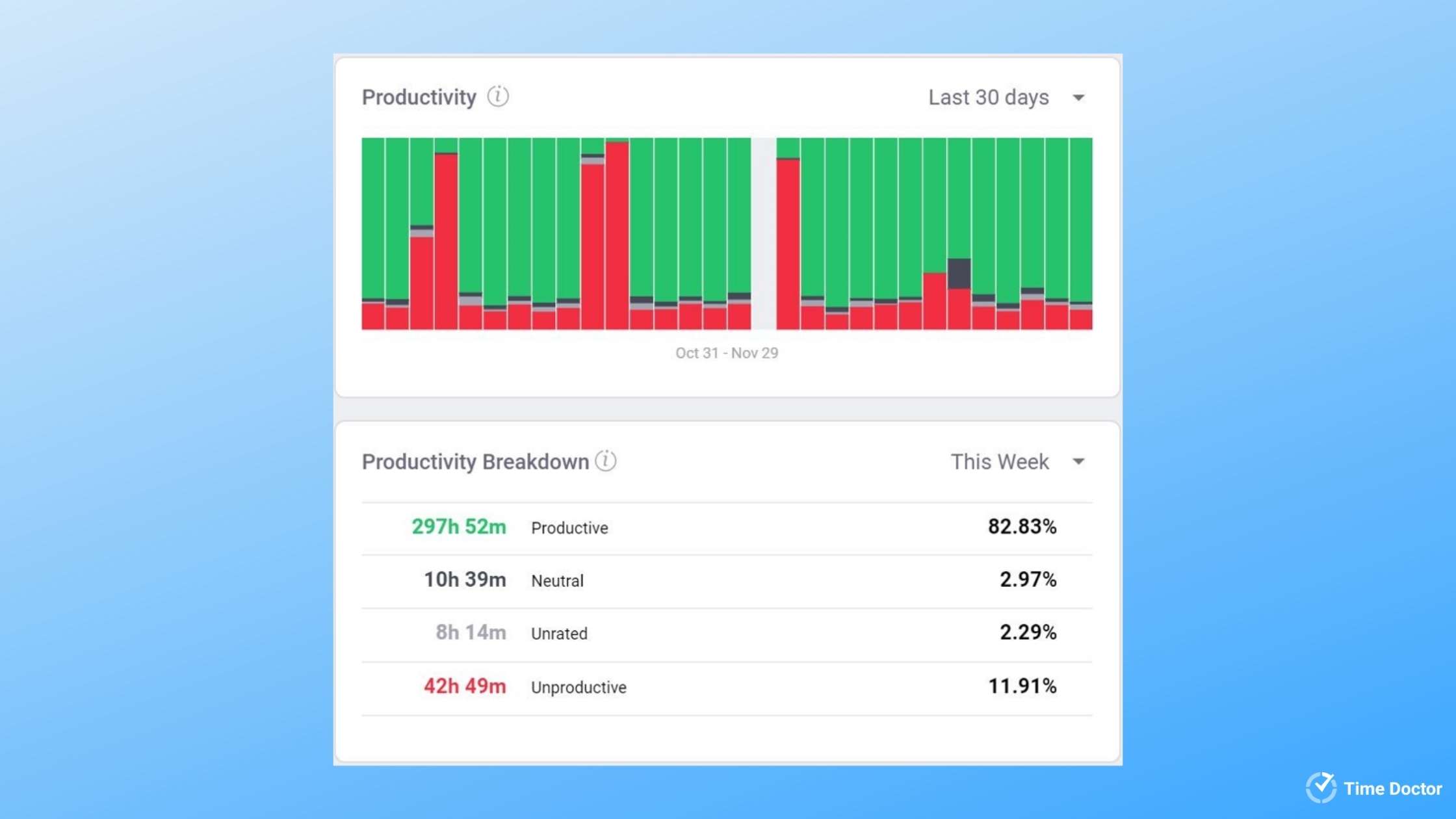Effective time management is a challenge for every company, no matter the size or industry. Employees, managers, and leaders are always looking for ways to improve efficiency at work which ultimately increases overall productivity and lowers costs.
The key to improve time management is knowing where your time is spent. By tracking and collecting workday data, you are enabling employees and management alike with the information needed to make strategic improvements. Without the data you don’t know what to improve on.
Types of workday data collected by Time Doctor
Time Doctor collects a ton of data that can be used to measure the time management of your teams. Here are some of the key metrics we track, divided into categories:
- Total time worked – Time Doctor is able to track data in real time via your desktop app or on your mobile device. Our tool will track all activity and continue to track until you click pause or stop. While Time Doctor isn’t tracking what happens on breaks, you are able to see break lengths and frequency.
- Start and end times – With our interactive application Time Doctor makes it easy for users to start and stop the timer giving reStal time attendance reports.
- Productive time – Time Doctor allows our clients to define what they consider to be productive or nonproductive time. By tagging websites and applications as productive, unproductive, or neutral you are able to see productivity breakdowns per user or team.
- Idle minutes and seconds – Time Doctor checks if there was any keyboard or mouse activity each minute or second. This allows you to gauge if the time spent during the workday was spent productively.
- Website and app usage – Time Doctor monitors and records what websites and applications each user and team visit throughout the day and how long they spend there. There is also the option to see the time spent on individual webpages and the titles of open windows giving you valuable insight into how teams spend their time at work.
- Hours worked on projects and tasks – Time Doctor records time spent on projects and their associated tasks giving you quick and easy progress report updates.
Actionable insights from Time Doctor data
Now that you have all this data in your hands, what can you do with it? We’ve pulled together some of the insights you can get from our workday data, what report it comes from, and how you can use it to increase the time management of your teams.
Identify high performers
By tracking where users are spending their time and how much time is spent being productive you can start to see who your top performers are in your team or organization. Use this data to reward or incentivize high performers to keep employee engagement up.
As you have probably already guessed, identifying high performers will ultimately bring to light the lower performers.
Low performers usually spend a lot of time on non-work related activities. This means their share of total unproductive time is higher than what you consider acceptable. By using the Web & App Usage report you can investigate what unproductive websites and apps each person has used. During this investigation it’s also a good time to revisit your productivity ratings in general to see if any of the neutral ratings should be changed unproductive.
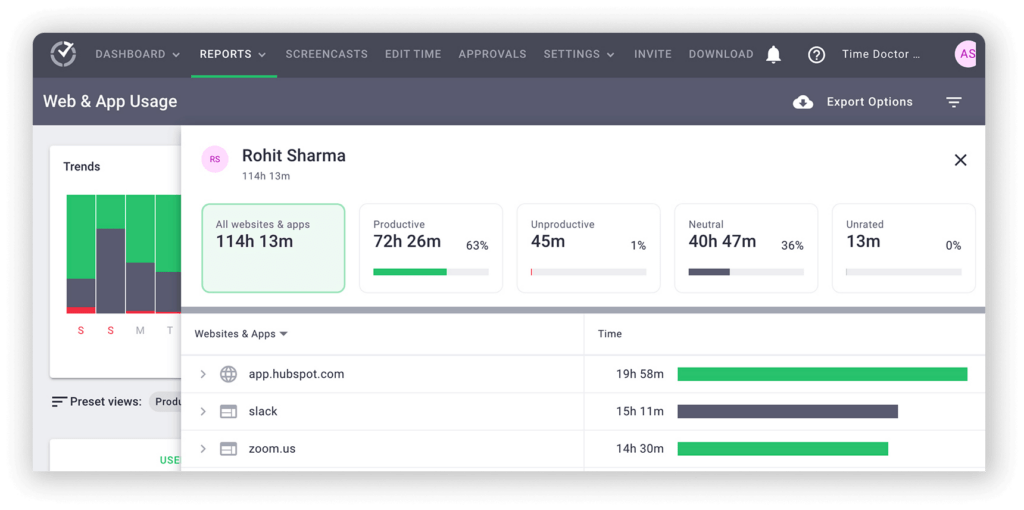
Another way to investigate low performance is to look at the idle minutes and seconds in the Activity Summary report. This will give you a better understanding of whether people are actively working or just have productive apps open. You do need to be careful when judging whether what you see is a problem or not, though. For some jobs, a high percentage of idle time is normal, such as users that spend most of their time on calls or doing other activities that don’t require them to use their keyboard or mouse a lot.
The best insights come from comparing people doing the same type of work and looking at idle time percentages over an extended period of time. This will help you to avoid worrying about individual days when users just happened to do work that required less keyboard/mouse activity.
Clicking on each cell showing idle minutes and seconds will open a side panel with more details on where this idle time was spent: on which websites, apps, and tasks.
Having this type of data in real time can help by giving you more time to implement the proper training and time management policies.
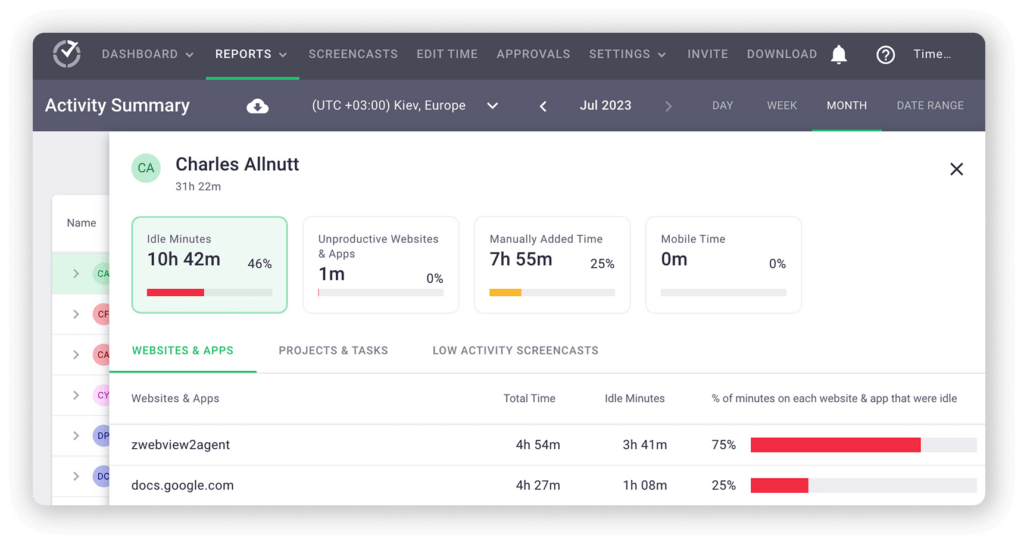
Uncover training opportunities
See when users are the most focused throughout their day. By checking the daily timeline of employees you can start to see trends or patterns in work behaviors. When you can identify the good time management behaviors you can replicate that throughout the team.
When reviewing the data perhaps you see users that change tasks too often without spending a reasonable amount of time on each of them continuously. They might also work for a short period of time, take a break, and work for another short period of time before taking another break. This kind of working pattern might lead to them being less focused on their work and needs to be corrected.
You can see each user’s working patterns in their individual user dashboard. Even if your users have flexible working hours, it’s often useful to know what their work trends are to see if there’s anything inefficient, such as a lack of continuous work on a task or late-night working hours.
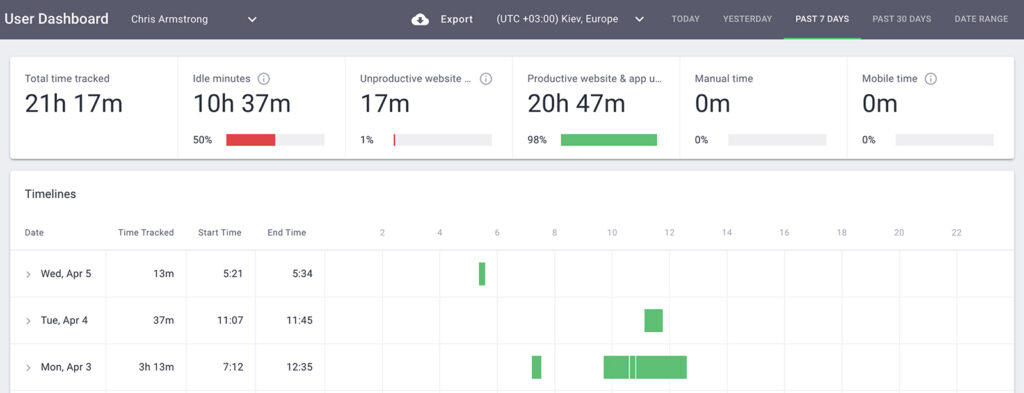
Collaboration opportunities
Promoting collaboration with teammates is an easy way to increase time management. When teams collaborate you are bringing together multiple resources to get tasks completed faster.
With most remote and hybrid teams you run into overlapping schedules due to different time zones. Also, teams with flexible schedules and unclear remote work policies can run into issues with team members not being available when they are needed.
This all could lead to lower efficiency if people who need to collaborate have to wait for each other to start working. You can see how team members’ work hours overlap in the Timeline report.
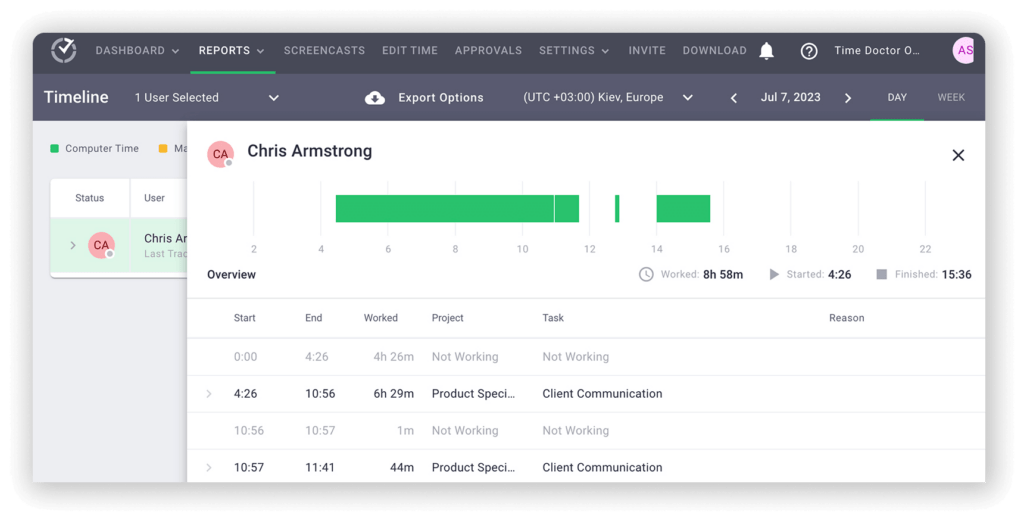
Along these same lines, using the Projects & Tasks report will show you a breakdown of the number of projects and tasks each user completes. If you see multiple users working on the same project or tasks frequently, you can use this data to identify a new area for collaboration to further increase efficiency.
Unevenly distributed work
Another quick way to increase time management is to make sure that workloads are even across the team. If certain team members are overworked overall productivity could be effected.
Time Doctor makes workload management easy by letting you compare the total time worked by users as well as the number of projects and tasks completed. Using the Hours Tracked report, you can see exactly who is working the most, who is consistently missing hours, and who works extended hours or late nights. This allows you to assign and reassign workloads more accurately without having to guess who has the bandwidth.
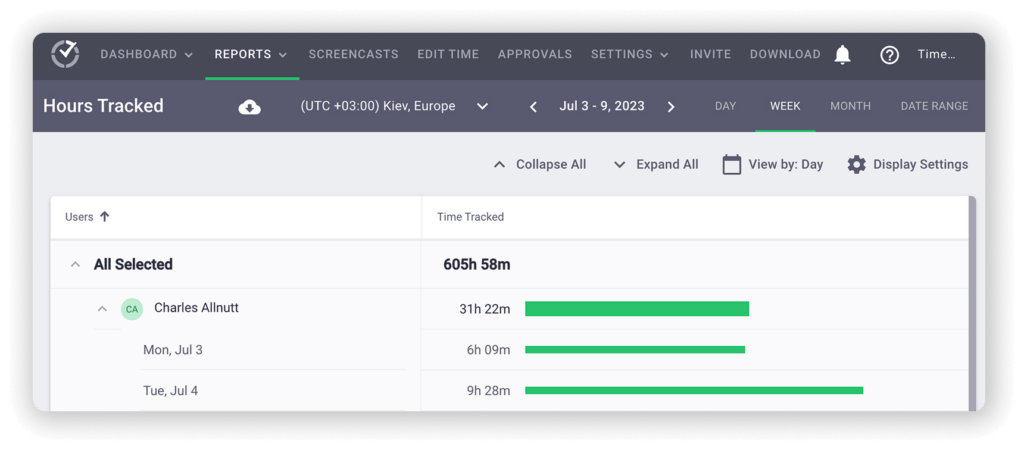
You can also use the Timeline report to help you identify peak productive days as well as what time of day is more productive for users. Use this data to assign urgent or last minute projects to the right people.
Improve project management
Good project management is something that every department needs to nail to be successful at time management. Time Doctor’s Projects & Tasks report provides valuable insights that will allow you to accurately forecast project timelines by getting real time progress updates. You can use this report to identify workflow inefficiencies by seeing where people get stuck. If you see a trend where multiple users are spending a lot of time on one task perhaps you need to revisit the process or there might be a way to implement automation to gain back valuable time.
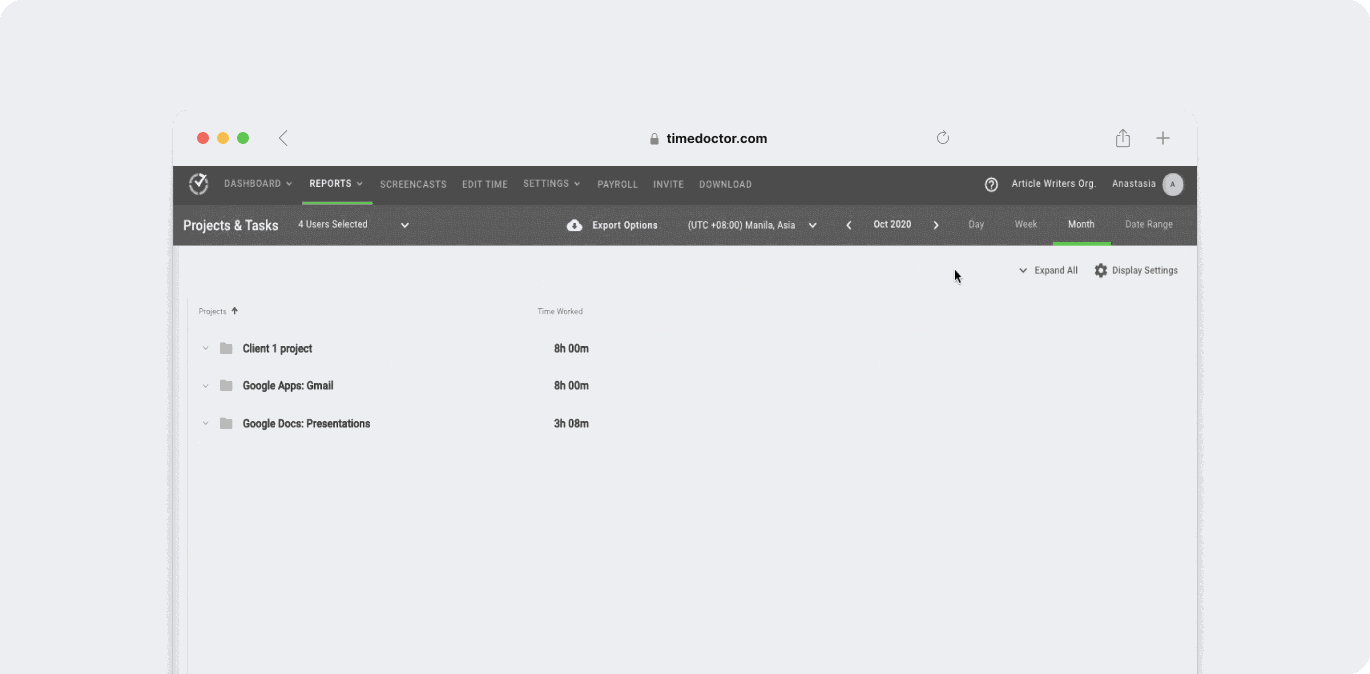
Improve new hire onboarding
It’s very important to start new hires off on the right foot. Instilling good time management habits, in the beginning, can help them become stellar employees. By using a combination of all Time Doctor reports you can follow new hires throughout their onboarding period. See how much time is being spent on training or spent with internal team members to make sure they are getting enough time with the right people.
Once projects and tasks are assigned to new hires, see where they are spending most of their time. Are they getting stuck on certain tasks? This could give managers insight into training that might need to be revisited.
Cost saving opportunities
While this might not have a direct tie to time management it’s an extra perk you get with using Time Doctor workday data so we wanted to share.
Another great use of the Web & App Usage report is using it to identify areas for cost savings. By tracking the total time spent on certain applications you can see what apps are used the most and if some are used at all. We had a client save over six figures when they were able to identify multiple unused licences of a design application.
Wrapping it up
We hope that this article has given you a better understanding of the power of Time Doctor’s workday data and how you can use it to improve the time management of your team.
If you want to see more insights and benefits of how Time Doctor can help your team click on the button below to book a personalized demo with one of our product specialists.

Rob Rawson is a co-founder of Time Doctor which is software to improve work productivity and help keep track of what your team is working on, even when working remotely.
